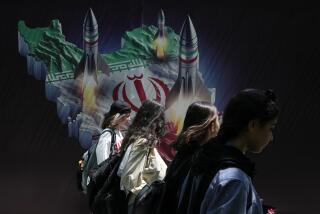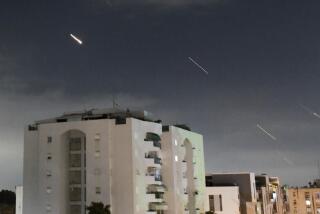Border Defeat Casts Doubt on Iran’s War Effort : Iraqis Report ‘Fierce Battle’ Near Basra but Indicate Foe ‘Had All Run Away’
SHALAMCHEH, Iraq — “We Are Men of War,” reads the large hand-painted sign written in Persian, the language of Iran. “Do Not Imagine You Can Defeat Us.”
Along with several abandoned crates of unused ammunition, the newly painted sign was the only evidence of 17 months of Iranian occupation encountered by the Iraqi troops who recaptured this battered border checkpoint in southern Iraq on Wednesday.
“It was a fierce battle,” said an Iraqi soldier at Shalamcheh. “But by the time we got here, the Iranians had gone. They had all run away.”
Indeed, all the available evidence pieced together by Western diplomats in Baghdad and by foreign reporters taken on a tour of the Shalamcheh region over the weekend suggests that, despite the bravado of the slogans they left behind, the Iranians withdrew from here without much of a fight.
Intense Speculation
This, in turn, has prompted intense speculation about whether Iran’s war effort, strained by serious manpower problems and reeling from a series of recent setbacks, is finally on the brink of collapse.
“Many people took it for granted that Iran could carry on with this war while continuing to suffer large casualties,” one Baghdad-based diplomat said, citing the Iranians’ revolutionary fervor and their 3-to-1 advantage in population. “But now may be the time to rethink this premise. The Iranians have suffered a lot lately, and they’re starting to show it.”
A trip to Shalamcheh these days requires a sturdy four-wheel-drive vehicle and a healthy appetite for dust.
It begins by crossing the Shatt al Arab waterway at a point just north of the southern port of Basra, then turning southeast and driving down across the narrow Jasim River, through mangled groves of shell-blasted date palms and past rings of tank-studded earthen walls until one arrives at what could pass for the End of the World: a surreal and lifeless landscape, choked with coils of barbed wire and littered with spent shell casings.
Here, in the dry season, the dust is so thick that, even from miles away, a moving jeep leaves a very visible trail for Iranian artillery gunners. From their side of the border, they try to guess the speed and direction and then take aim at the moving clouds left in the vehicle’s wake.
Every now and then, an incoming shell lands with a dull thud in this cratered, sun-bleached wasteland, sending up a pretty plume of sand and dust. For the most part, however, it is eerily quiet as a small convoy of vehicles bounces almost blindly along the uneven dirt tracks, enveloped in a hazy cocoon of fine yellow sand.
But once at Shalamcheh, which lies less than two miles west of the border, the visitor finds a curious sight. The Iraqis have brought up a refrigerated truck and, on Friday, were waiting with glasses of ice-cold mineral water for the first Western reporters to reach the battlefront. Other soldiers were rummaging through the bunkers hastily vacated by the Iranians only two days earlier at the end of the nine-hour-long blitzkrieg by troops from Iraq’s 3rd Army and the elite Presidential Guards.
Yet the oddest thing about Shalamcheh now is that, while it has been pummeled into powder by years of artillery fire--first by Iran and then by Iraq--there is little evidence of the fierce fighting that Iraq says took place there before the Iranians retreated. This pile of rubble, honeycombed with bunkers and cratered by artillery fire, was supposed to have been the strategic prize of Iraq’s most significant victory over Iran in 7 1/2 years of war.
In reaching Shalamcheh, the Iraqis cleared a narrow corridor of land north of the Shatt al Arab and south of a man-made water barrier known as Fish Lake and relieved the pressure on Basra, 25 miles to the west. That achievement, coming on the heels of Iraq’s successful offensive to recapture the Faw Peninsula last month, finally eliminated the Iranian threat in the south.
The Iraqis said they routed five divisions of Iranian troops from Shalamcheh and positions around the southeastern end of Fish Lake in their blitz. But while the reporters did see evidence of fighting in places--the bodies of dozens of dead Iranians and the twisted, blackened remains of several tanks--they saw nothing suggesting a major battle, and the tour raised many more questions in the end than it answered. Indeed, Iraqi officers were under strict orders, from what was said to be the political department of the army, to answer no questions at all.
They were extremely polite, treating the reporters, at 3rd Army headquarters, to a lavish lunch of lamb, grilled meats, fresh vegetables, fruit and vanilla and chocolate pudding for dessert. But they were rigorous in their refusal to answer questions, even seemingly innocuous ones.
When a senior officer was asked if the fighting had been heavy, he shrugged his shoulders and replied, “I don’t know.” When the soldier at Shalamcheh, apparently unaware of the restrictions, started describing the Iranian rout, he was quickly cut off by the reporters’ escort officer.
This reticence seemed odd because, on previous battlefront tours, the Iraqis trundled out generals and field commanders for press conferences that became tests of endurance as the officers boasted about their victories at great length. Yet, even if the Iranians failed to fight hard this time, the offensives at Faw and Shalamcheh were genuinely important victories for the Iraqis, victories that may even have turned the tide of the war decisively in Iraq’s favor, diplomats in Baghdad said.
Further, the diplomats added, the offensives were cleverly planned and well-executed operations that have done much to erase the negative impression that Western military analysts had begun to form of the well-equipped but seemingly gun-shy Iraqi army. “The Iraqi strategy this time was brilliant,” one diplomat said. “They planned well, and they took the Iranians completely by surprise.”
Thus, one of the questions the diplomats are puzzling over at the moment is why the Iraqis are not boasting now, when they have something genuine to boast about. One possible answer is that, if Faw and Shalamcheh were indeed walkovers, the Iraqis might not want it known because it would tend to diminish the dimensions of the victories they are claiming.
Even more puzzling is why the Iranians retreated so quickly from their most important foothold in Iraq. “Everything we’ve seen at both Faw and Shalamcheh is completely uncharacteristic of the Iranians,” a Western military analyst said. “They don’t seem to have been taking many casualties there, so their retreat is a real mystery.”
One line of speculation is that the Iranians, unable to launch a winter offensive after this year’s recruitment drive fell considerably short of its target, had thinned out their forces in the south, diverting them to the northern front in the belief that the Iraqis would not attack in the south.
“They gambled and lost,” the military analyst said. “At the same time, the Iraqis played it very well. They mounted a good, swift maneuver.”
“The Iraqis used brilliant tactics,” another diplomat said. “They seem to have fooled the Iranians completely.” He pointed out that, just a few days before the Shalamcheh offensive, the Iraqis moved large numbers of the Presidential Guards from the southern sector to the northern war front, “and rumors were rife around here that the big attack would be up north.
“They used the same strategy against the Iranians as the Iranians used against them when they attacked Fish Lake last year after a diversionary strike in the central sector,” the diplomat added, noting that, in both cases, “it worked.”
What the reporters saw on their restricted and carefully controlled tour reinforced the impression that the Iranian occupation force had been taken by surprise. They saw about a dozen blasted tanks and other tracked vehicles, although a few looked like they could have been knocked out in earlier fighting.
Along one side of a dirt road near the Duayji River, just south of the Jasim, the reporters counted the sun-blackened bodies of 13 Iranians. Just before reaching a small, shell-damaged bridge over the river itself, they saw perhaps another 20 or 30 bodies clustered in several mounds.
At 3rd Army headquarters, they were shown about 350 Iranian prisoners sitting in ragged rows on an asphalt lot under the hot sun. The POWs were shown to reporters on the condition that no questions be asked. The escort officer said all the prisoners captured in the Shalamcheh offensive were being brought to the army headquarters for identification before being sent to internment camps farther north.
Most of the prisoners appeared to be in their 20s and 30s, but there were a few who seemed to be not even in their teens, and there was one white-haired man who an Iraqi officer said was 70.
“Look at them,” the officer said. “They send even their children and their old men to fight us.”
More to Read
Sign up for Essential California
The most important California stories and recommendations in your inbox every morning.
You may occasionally receive promotional content from the Los Angeles Times.










